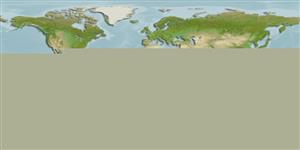Common names from other countries
Teleostei (teleosts) >
Blenniiformes (Blennies) >
Blenniidae (Combtooth blennies) > Salariinae
Etymology: Praealticus: Latin, prae = in front of + Latin, altus, alticus = nutritious.
Environment: milieu / climate zone / depth range / distribution range
Ecology
Marine; demersal. Tropical
Western Pacific: South China Sea.
Size / Weight / Age
Maturity: Lm ? range ? - ? cm
Max length : 9.0 cm TL male/unsexed; (Ref. 90102)
Dorsal spines (total): 12 - 14; Dorsal soft rays (total): 16 - 20; Anal spines: 2; Anal soft rays: 18 - 22. Greenish grey, white on abdomen, numerous dark vertical lines on cheek, snout, and lips, about 5 pairs of dark bars on side of body, outer part of soft dorsal fin with oblique yellow bands, and middle of caudal-fin base with blackish blotch/steak. Dorsal fin deeply notched; segmented caudal rays typically 13-14, branched middle 1-8; pinnately branched supraorbital tentacle; lacking nape cirri; posterior rim of anterior nostril with small cirrus (typically unbranched); upper and lower lip margin crenulate; males with occipital crest; last dorsal ray and caudal peduncle connected by membrane; elongate body, depth at anal-fin origin ca. 6.0-6.6 in SL. Maximum length 9 cm TL (Ref. 90102).
Facultative air-breathing (Ref. 126274); Adults inhabit rocky shores and intertidal zone (Ref. 90102). Oviparous. Eggs are demersal and adhesive (Ref. 205), and are attached to the substrate via a filamentous, adhesive pad or pedestal (Ref. 94114). Larvae are planktonic, often found in shallow, coastal waters (Ref. 94114).
Life cycle and mating behavior
Maturities | Reproduction | Spawnings | Egg(s) | Fecundities | Larvae
Oviparous, distinct pairing (Ref. 205).
Randall, J.E. and K.K.P. Lim (eds.), 2000. A checklist of the fishes of the South China Sea. Raffles Bull. Zool. Suppl. (8):569-667. (Ref. 36648)
IUCN Red List Status (Ref. 130435)
CITES (Ref. 128078)
Not Evaluated
Threat to humans
Harmless
Human uses
Tools
Special reports
Download XML
Internet sources
Estimates based on models
Preferred temperature (Ref.
115969): 25.8 - 29.3, mean 28.7 (based on 1331 cells).
Phylogenetic diversity index (Ref.
82804): PD
50 = 0.5001 [Uniqueness, from 0.5 = low to 2.0 = high].
Bayesian length-weight: a=0.00741 (0.00335 - 0.01640), b=3.02 (2.83 - 3.21), in cm Total Length, based on LWR estimates for this (Sub)family-body shape (Ref.
93245).
Trophic level (Ref.
69278): 2.0 ±0.00 se; based on food items.
Resilience (Ref.
120179): High, minimum population doubling time less than 15 months (Preliminary K or Fecundity.).
Fishing Vulnerability (Ref.
59153): Low vulnerability (10 of 100).
